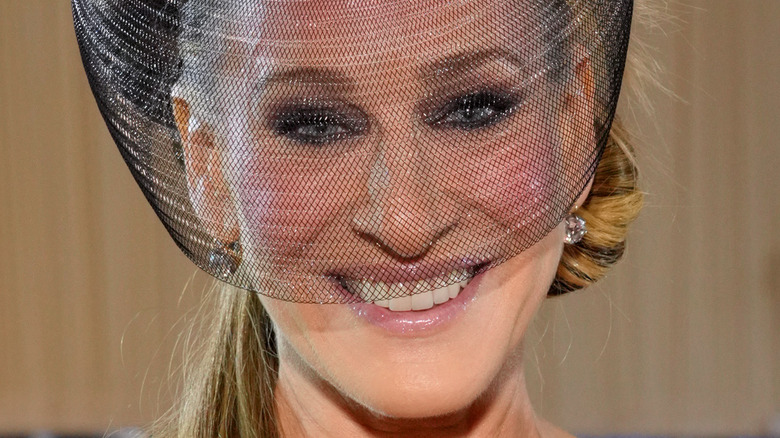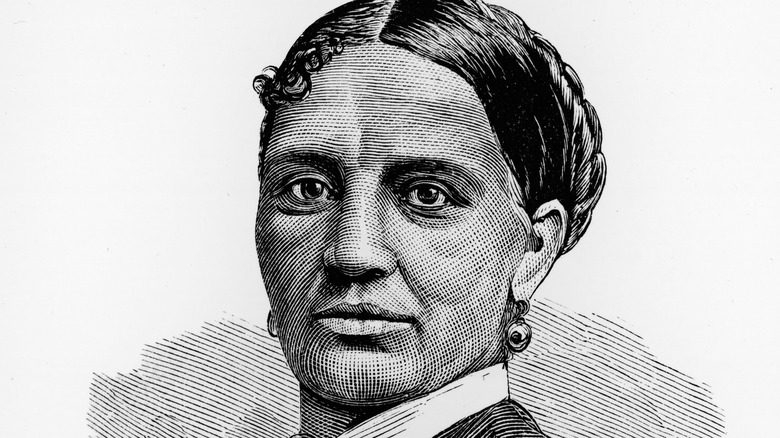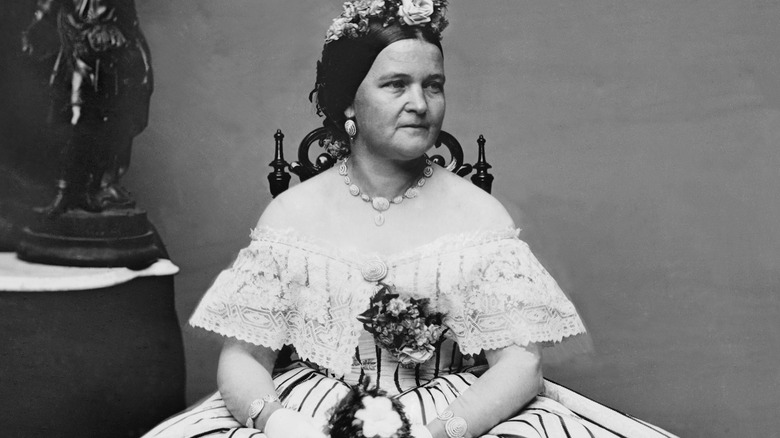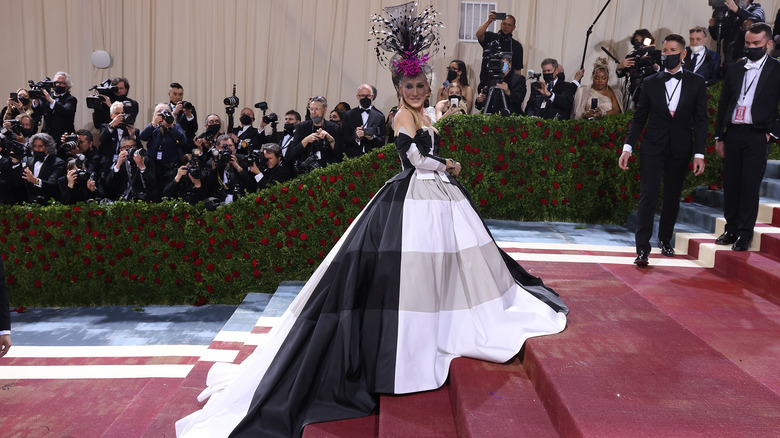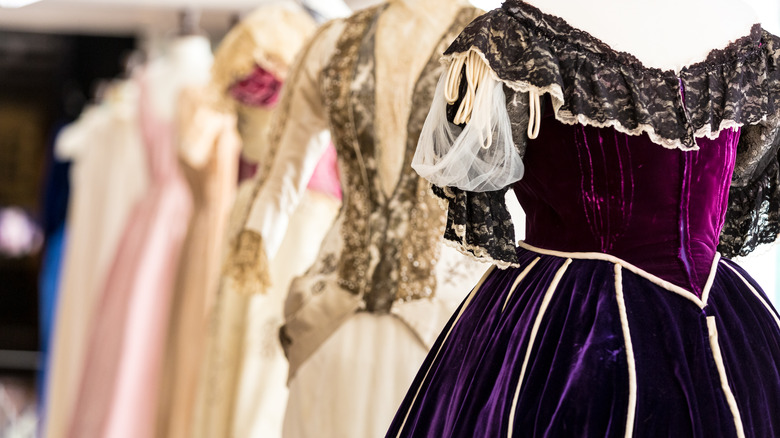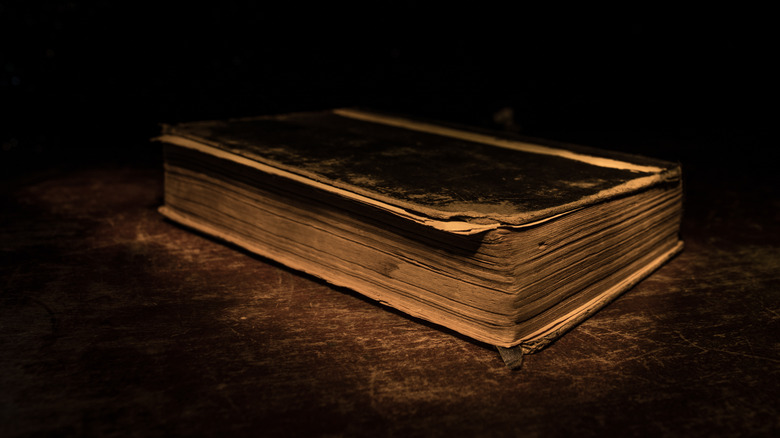Sarah Jessica Parker's 2022 Met Gala Dress Honored A 19th Century Black Woman
According to the BBC, the 2022 Met Gala celebrated the Gilded Age, a time period in the U.S. known for its economic growth and prosperity. The Guardian writes that the "Gilded Glamor and White Tie” theme has been heavily criticized in the days since the event. Many have stated that it's simply too "out of touch” (via The Independent). The Gilded Age, which took place between 1870 and 1890, can be described, in one word, as opulent. Per Vogue, the fashion featured during this time included silk, ruffles, fringe, and more. But while many were living in luxury, others were impoverished and suffering.
As the New York Post explains, during the Gilded Age, the less fortunate were merely trying to survive. CNN reports that a few celebrities honored those who were ignored and forgotten during that time in history. For example, actress Gabrielle Union wore a silver gown with a sizable red flower on her waist that in her words represented "the blood spilled during the accumulation of gross wealth by a few during the Gilded Age, off of the backs of Black people and people of color in this country."
Actress Sarah Jessica Parker paid tribute to a Black woman with her dress, as it was inspired by Elizabeth Hobbs Keckley, the first black female designer in the White House. Although Keckley worked before the Gilded Age, it was a poignant statement made by Parker nonetheless.
Who was Elizabeth Keckley?
According to Women & the American Story, Keckley was born into slavery in Virginia in 1818. The White House Historical Association explains that she was most likely the product of a non-consensual relationship between her mother, Aggy, and her master, Colonel Armistead Burwell. As a child, Aggy taught her daughter how to sew, and this later became Keckley's saving grace. It would be an understatement to say that she lived a life of hardship. As a slave, Keckley was regularly mistreated and physically abused. Nonetheless, she persevered and began to make dresses to make money for her enslavers when they were in need of funds.
Keckley did this to prevent her aging mother from being rented out as a servant (via Women & the American Story). At this point, she, her mother, and her only son, named George, were living in St. Louis, Missouri with the Colonel's daughter. Her dresses were a hit. Racked reports that Keckley's reputation as a dressmaker quickly grew. She also received a marriage proposal from James Keckley, a free Black man. However, she refused to marry him because she was still enslaved. Ultimately, this inspired Keckley to seek out her freedom.
JSTOR Daily writes that she was eventually able to buy her and her son George's freedom for $1200, or $40,000 in 2022. Keckley was able to raise the money using the connections she had made with her dressmaking. It took her five years to pay the debt back.
Elizabeth Keckley and her friendship with Mary Todd Lincoln
Although she did marry James Keckley, the marriage fell apart and she moved to Washington D.C. in 1860 (via Racked). Keckley had little issue establishing herself in this new city. She first found work as a seamstress, but worked her way up. Per Women & the American Story, her connections to St. Louis' elite undoubtedly helped her find new wealthy customers. However, Keckley met the woman who would change her life soon after. According to the White House Historical Association, Keckley was introduced to Mary Todd Lincoln, wife of then President Abraham Lincoln, when another of one Keckley's clients recommended her as a dressmaker.
Smithsonian Magazine writes that Keckley was promptly hired to be Lincoln's dressmaker and stylist. This was after President Lincoln took one look at a dress his wife was wearing and stated, "You look charming in that dress. Mrs. Keckley has met with great success." Moreover, her association with Mary created buzz around her business, which led her to open her own dress shop.
Their partnership, however, went beyond dressmaking; Keckley and Mary became very good friends. When Mary's son Willie died, her grief brought her closer to Keckley, as her son George had also died months earlier in the Civil War. Keckley also comforted Mary when Lincoln was assassinated in April, 1965 (per the White House Historical Association).
Sarah Jessica Parker's gown was inspired by a dress worn by Mary Todd Lincoln
For the 2022 Met Gala, Vogue writes, Parker wore a dress designed by Christopher John Rogers. Her intention was to pay tribute to Keckley, someone she believes has been largely forgotten by history. Rogers explained that "The idea was to highlight the dichotomy between the extravagant, over-the-top proportions of the time period, and the disparity that was happening in America at the time." Rogers and Parker were inspired by a black and white gingham dress designed by Keckley that is now at the Chicago History Museum. The dress was made for none other than Mary Todd Lincoln. It features three pieces and includes a cape.
Parker's ball gown is also black and white and includes a fitted top and train. Per Vogue, silk faille, moire, taffeta, and swarovski crystals were used to create the garment. Town & Country writes that the look was finished with a veil made by hat designer Philip Treacy. Unlike Mary's dress, Parker's lacked a cape and the neckline was lowered. These decisions were made to keep the look somewhat modern. The Chicago History Museum explains that it's unknown if Mary's gingham dress was actually designed by Keckley. As was the custom of the time, the dress does not have any labels, but is believed to be a prime example of Keckley's stylistic choices.
Elizabeth Keckley's designs were ahead of her time
The Chicago History Museum writes that Keckley was known for her simple, understated designs. Smithsonian Magazine states that her dresses were rather plain compared to what was expected during the Victorian era. Nonetheless, Keckley's designs were sought out for a reason; they fit the wearer like a glove and were exceptionally streamlined (via Racked). As Elizabeth Way, a fashion historian, explained, "looking at the details of Keckly's limited number of extant garments, one aspect becomes clear: She appreciated clean lines and unpretentious designs" (per the Fashion Institute of Technology). Per Smithsonian Magazine, the dresses designed for Mary Todd Lincoln by Keckley were different from what the first lady usually favored.
While Mary was a fan of bright and bold patterns, Keckley's designs were the complete opposite. This can be seen in a purple velvet dress (a replica can be seen above) made for Mary. The Fashion Institute of Technology notes that the silhouette is typical for the time. However, the dress lacks any embellishments and instead uses white piping to capture a viewer's attention. Some believe that this was to prevent any criticism for being too lavish during the Civil War (per Racked). Rather then let herself be influenced by European designs and Victorian customs, her designs show Keckley's efforts to modernize and uncomplicate American womenswear.
The book that led to Elizabeth Keckley's decline
Beyond dressmaking, Keckley was known for supporting charitable causes (via White House Historical Association). She helped create the Contraband Relief Association to aid the enslaved who had escaped during the Civil War. (Keckley asked Mary for a donation, and she obliged.) The Virginia Museum of History & Culture writes that Keckley also contributed in creating educational programs for the former enslaved. Additionally, she established the National Home for Destitute Colored Women and Children in her later years (per the Chicago History Museum). In 1867, Mary Todd Lincoln, who was in severe debt, asked Keckley for her help.
Women & the American Story reports that she assisted Mary in selling some of her wardrobe and jewelry. However, the sale was heavily criticized and tarnished Mary's reputation. Moreover, Keckley donated some of Lincoln's items without Mary's permission, which further strained their friendship. The final nail in the coffin was Keckley's autobiography, "Behind the Scenes, or, Thirty Years a Slave, and Four Years in the White House."
Published in 1868, JSTOR Daily states, the book reveals intimate details about her friendship and time with the Lincolns. Although Keckley hoped the book would help Mary's cause, it was seen as a betrayal and led to the end of their friendship (per Women & the American Story). The book was panned and Keckley's businesses suffered because of it. She later took a position at Wilberforce University before suffering a stroke in 1893. Keckley subsequently retired and lived out her days at the Home for Destitute Colored Women and Children, which she had helped establish, and where she died in 1907.
